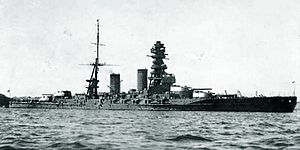
Back Муцу (линеен кораб, 1920) Bulgarian Mucu (1920) Czech Mutsu (Schiff, 1921) German Mutsu (1921) Spanish نبردناو موتسو Persian Mutsu (1920) Finnish Mutsu (cuirassé) French Mucu japán csatahajó Hungarian Kapal tempur Jepang Mutsu ID Mutsu (nave da battaglia) Italian
 Mutsu around 1922
| |
| History | |
|---|---|
| Name | Mutsu |
| Namesake | Mutsu Province |
| Builder | Yokosuka Naval Arsenal |
| Laid down | 1 June 1918 |
| Launched | 31 May 1920 |
| Commissioned | 24 October 1921 |
| Stricken | 1 September 1943 |
| Fate | Sunk by internal explosion, 8 June 1943 |
| General characteristics (as built) | |
| Class and type | Nagato-class battleship |
| Displacement | 32,720 t (32,200 long tons) (standard) |
| Length | 215.8 m (708 ft) (o/a) |
| Beam | 28.96 m (95 ft) |
| Draft | 9 m (29 ft 6 in) |
| Installed power |
|
| Propulsion | 4 shafts; 4 × steam turbines |
| Speed | 26.5 knots (49.1 km/h; 30.5 mph) |
| Range | 5,500 nmi (10,200 km; 6,300 mi) at 16 knots (30 km/h; 18 mph) |
| Complement |
|
| Armament |
|
| Armour |
|
| General characteristics (1943) | |
| Displacement | 39,050 tonnes (38,430 long tons) (standard) |
| Length | 224.94 m (738 ft) |
| Beam | 34.6 m (113 ft 6 in) |
| Draft | 9.46 m (31 ft) |
| Installed power |
|
| Speed | 25.28 knots (46.8 km/h; 29.1 mph) |
| Range | 8,650 nmi (16,020 km; 9,950 mi) at 16 knots (30 km/h; 18 mph) |
| Complement | 1,475 |
| Armament |
|
| Armour |
|
| Aircraft carried | 3 × floatplanes |
| Aviation facilities | 1 × catapult |
Mutsu (陸奥) was the second and last Nagato-class dreadnought battleship built for the Imperial Japanese Navy (IJN) at the end of World War I. She was named after the province. In 1923 she carried supplies for the survivors of the Great Kantō earthquake. The ship was modernized in 1934–1936 with improvements to her armour and machinery, and a rebuilt superstructure in the pagoda mast style.
Other than participating in the Battle of Midway and the Battle of the Eastern Solomons in 1942, where she did not see any significant combat, Mutsu spent most of the first year of the Pacific War in training. She returned to Japan in early 1943. That June, one of her aft magazines detonated while she was at anchor, sinking the ship with the loss of 1,121 crew and visitors. The IJN investigation into the cause of her loss concluded that it was the work of a disgruntled crew member. The navy dispersed the survivors in an attempt to conceal the sinking in the interest of morale in Japan. Much of the wreck was scrapped after the war, but some artefacts and relics are on display in Japan, and a small portion of the ship remains where she was sunk.